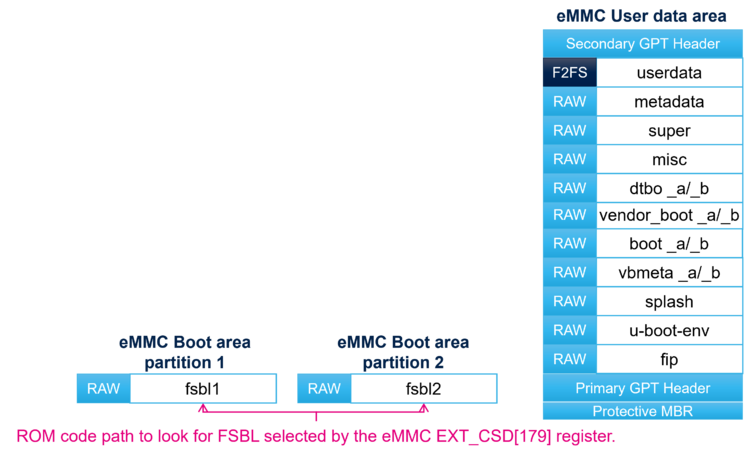This article shows the mapping used in STM32MPU Embedded Software distribution for Android™ for ST boards, which can be used as a starting point for other boards.
1. Supported flash memory technologies[edit | edit source]
The STM32MP2 series supports different types of flash memories. For Android, it has been limited to e•MMC devices connected to an SDMMC interface. As the eMMC area can be limited, a hybrid configuration is also available for test and demonstration purpose, using an SD card for data partitions.
2. Flash partitions[edit | edit source]
The tables below list the partitions defined for STM32MP2 boards in Cortex®-A main processor mode and give typical sizes with OpenSTDroid, which can be tuned depending on the targeted application needs.
| Size | Component | Comment |
|---|---|---|
| Remaining area | userdata | The user file system. It contains user data and examples. |
| 16 Mbytes | metadata | This partition contains the userdata metadata. |
| 1.4 GKbytes | super | This partition contains Android system, system_ext, vendor, and product logical partitions. |
| 512 Kbytes | misc | This partition contains a raw partition used to share information between Android and the bootloader. |
| 512 Kbytes | dtbo | This partition contains the kernel device tree overlay (board configuration). |
| 16 Mbytes | vendor_boot | This partition contains the kernel device tree (SoC configuration) and the vendor ramdisk. |
| 64 Mbytes | boot | This partition contains the Linux® kernel image and the generic ramdisk. |
| 512 Kbytes | vbmeta | This partition contains the metadata required for the verified boot mechanism. |
| 512 Kbytes | splash | This partition contains the splash screen image (bmp format). |
| 512 Kbytes | u-boot-env | This partition is used to store the U-Boot environment. |
| 4 Mbytes | fip | The TF-A firmware image package (FIP) is a binary file that encapsulates several binaries, as well as their certificates (optionally, for authentication), which are loaded by TF-A BL2. OpenSTDroid FIP contains:
|
| 512 Kbytes | fsbl | This partition contains at least two copies of the Arm® Trusted Firmware (TF-A) first stage bootloader. |
3. eMMC memory mapping[edit | edit source]
The eMMC embeds four physical partitions:
- Boot area partition 1: one copy of the FSBL
- Boot area partition 2: one copy of the FSBL
- User data area: formatted with GPT partitioning and used to store all remaining partitions
- Replay Protected Memory Block (RPMB): not shown in the figure below.
The STM32CubeProgrammer must be used to prepare the eMMC with the layout shown below, and to populate each partition.
| The boot area partition used by the eMMC boot sequence is selected via the EXT_CSD [179] register of the eMMC. The STM32CubeProgrammer execution is concluded with the selection of the last written partition from the flashlayout file, typically partition 2. The other copy is never used as long as the user does not explicitly change the eMMC EXT_CSD[179] register to select it. |

4. Flashing the built images[edit | edit source]
When the distribution has been built, refer to the How to populate boards for Android page for how to flash your device.